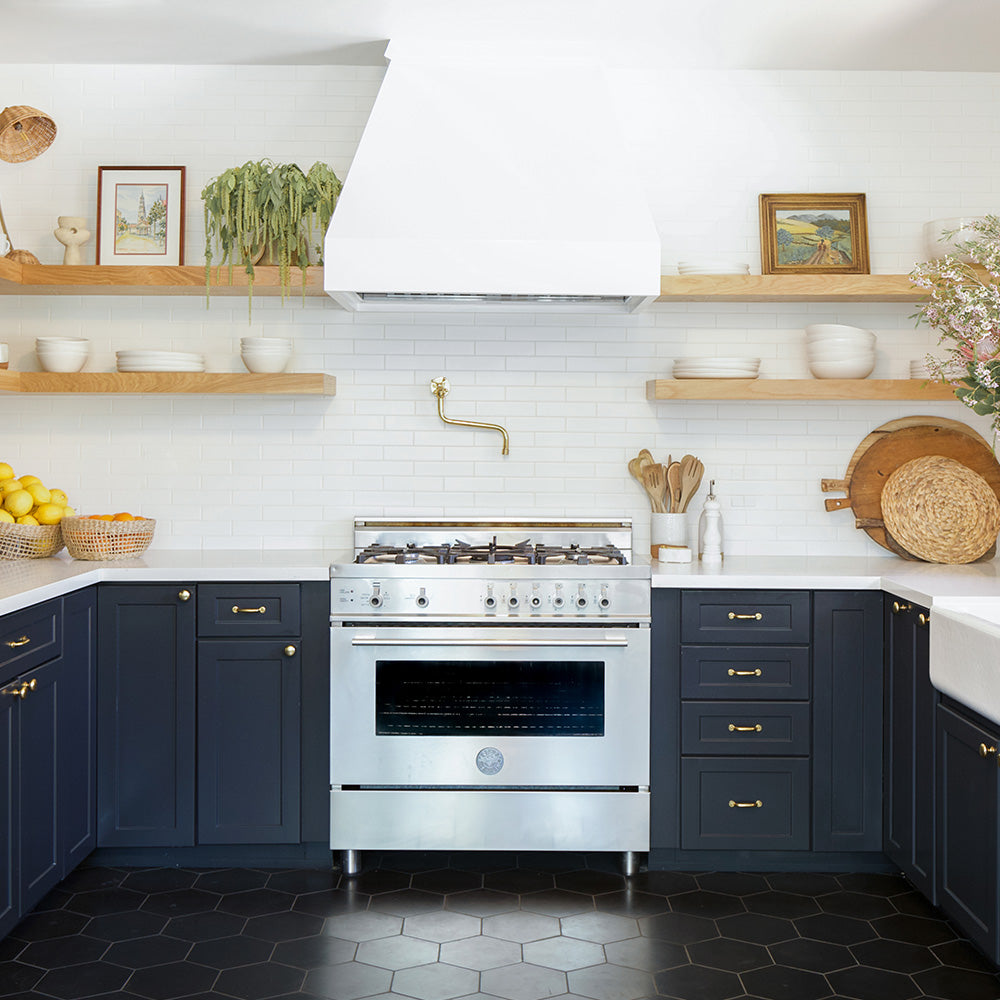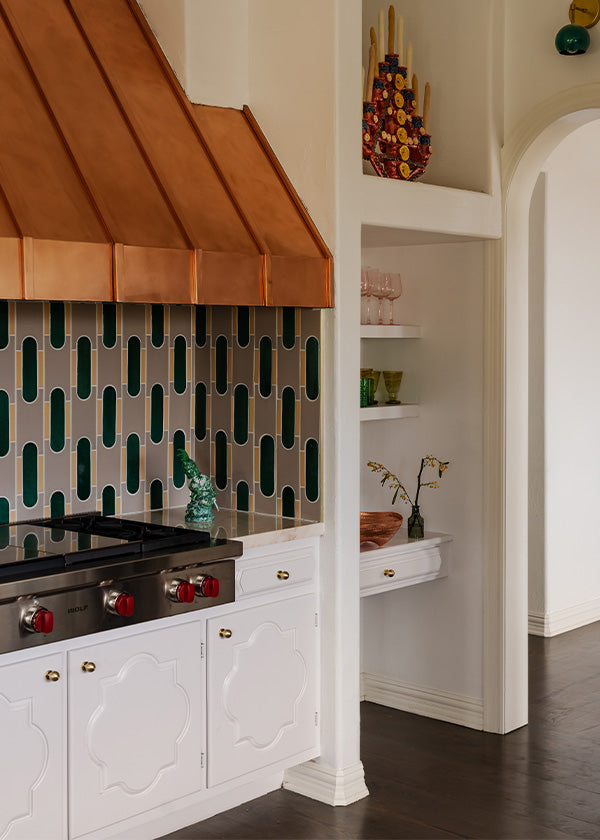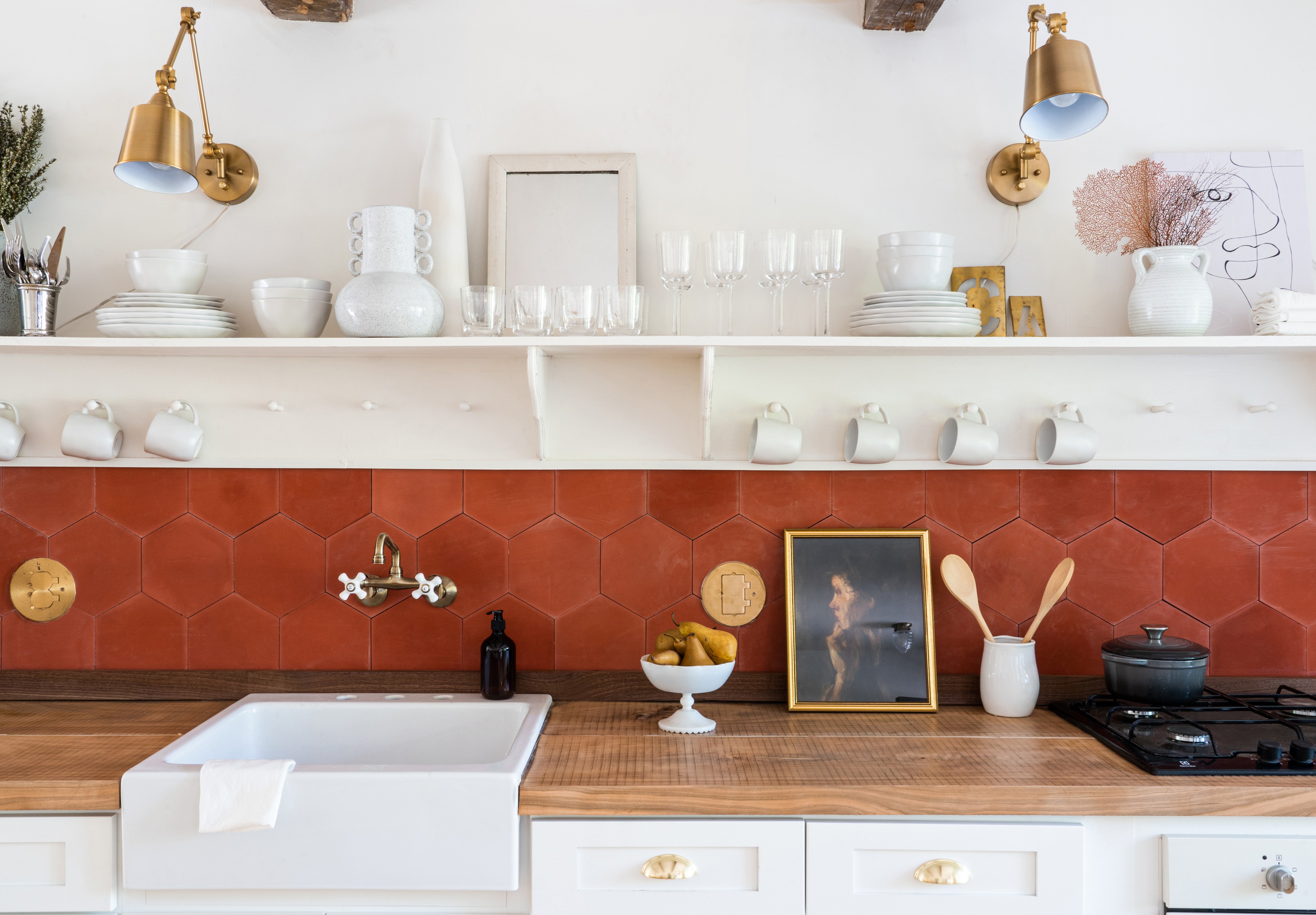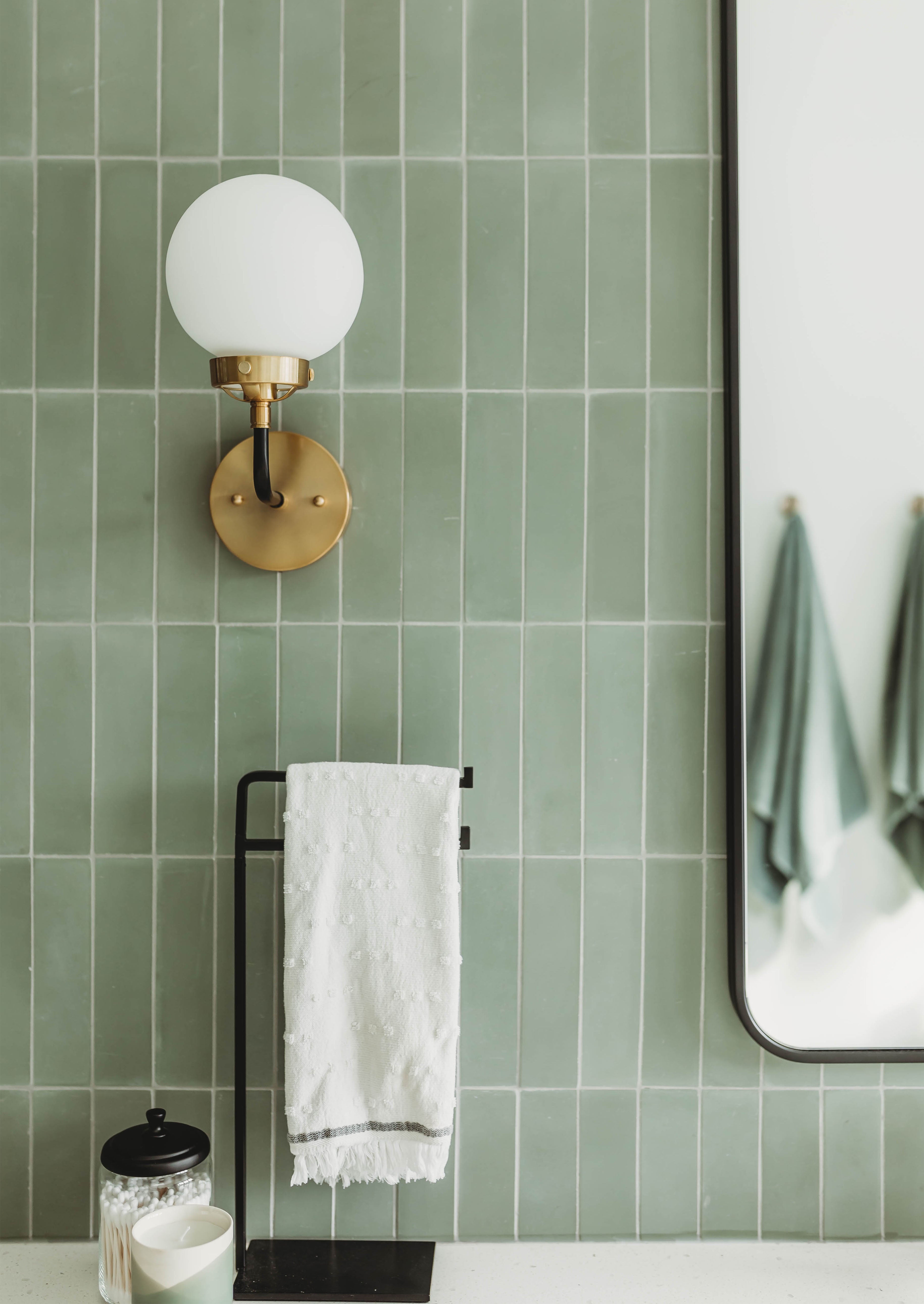cement tile vs. ceramic tile: the differences explained
by clé tile | published: Jan 29, 2024

floor: 8x8 black cement hex; wall: 2x8 subway ceramic in matte white. design: margaret costello interiors / photo: scarlett mcdonald
Cement and ceramic—two similar sounding words, two very different types of tile. we’re exploring common questions and key differences between them below, including how they’re made, how they look, where they’re best installed, and how they wear over time.
the main difference between cement tile and ceramic tile
to understand the main difference between cement and ceramic tile, you need to look at the fundamental materials (cement and ceramic, specifically) and how each of them comes to life. in a nutshell: cement tiles are unglazed and unfired tiles formed from various layers of cement. ceramic tiles, while they can be unglazed, are generally glazed tiles that are formed from clay and then fired at high temperatures.
let’s dive into cement tile more specifically. cement tile is made from portland cement (a combination usually consisting of limestone, shale, and clay minerals) and pigment. (note that concrete and cement are not synonymous: concrete is a composite material consisting of aggregate such as gravel and sand, cement, and water, while cement is made using metal molds following a process perfected by artisans in catalonia, spain.) first, pigments are added to the molds, followed by portland cement. then, each tile is pressed by a hydraulic press and sent through a water bath before being stacked away to dry and cure. this last step allows the pigments to develop even further—and the tile only gets better with age. remember that no kilns are involved in crafting cement tile.
then there’s ceramic tile. this type of tile is shaped from natural clay and allowed to dry thoroughly. some ceramic tiles are left unglazed, while many are glazed before being fired in a kiln. this firing bonds the glaze to the body of the tile.

fornace brioni + cristina celestino glazed ceramic tivoli. design: lala reimagined / photo: ori harapz

8x8 square cement solid in metal + white. design: larapin design / photo: amanda proudfit
cement tiles vs. ceramic tiles
cement and ceramic tile certainly share many similarities (they’re both popular for a reason, after all) but each material offers unique advantages.
aesthetics
cement tile can take on a world of different looks, thanks to how it’s made. pigments are used to create dazzling patterns like those of our granny squares collection, bold colors à la our mythology collection, and neutral-leaning tiles too. another thing worth noting: it’s prone to patina, giving it a lived-in, perfectly imperfect look over time.
ceramic tile offers a host of possibilities, too, since it can be glazed or left unglazed. options range from earthy unglazed tile and classic white subway tile to bold shapes and hand-painted patterns. where cement tile is highly prone to patina, ceramic tile (especially glazed ceramic tile) maintains a more consistent look over time.
durability
cement and ceramic tile are both remarkably durable—given the proper treatment, of course. cement is a popular choice for residential and commercial spaces alike, including walls, backsplashes, and even high-traffic flooring. with a little tlc such as sealing and gentle cleaning, it can last for generations.
ceramic has quite the lifespan, too, and is beloved for its ability to resist water, scratches, and stains (especially when it’s glazed). with a few common-sense practices like keeping sharp or heavy objects away from your ceramic tile, you’ll enjoy it for many years.
maintenance and cleaning
cement tile can be easy to maintain, but that doesn’t mean it’s low maintenance. it should be sealed regularly to keep it resistant to water, stains, and scratches. if properly finished with a sealer, cleaning with a ph-neutral cleaner and a soft cloth is usually sufficient.
for an option that requires a little less upkeep, you may prefer glazed ceramic tile. it’s highly resistant to water, stains, and scratches on its own and generally doesn’t need to be sealed. (keep in mind that unglazed options may need more involved maintenance.) like cement, ceramic tile is best cleaned with a gentle cleaner.
one more thing worth noting: glazed ceramic tiles are a great option for busy households with concerns about staining and maintenance. however, this also means the tiles cannot be refinished like cement tiles can be. if you want a tile option that can be refinished and last for generations, you may prefer cement.

cement solid 8x8 hex in barn. design: old mill guest house / photo: nina barry
practicality and location of installation
cement tile develops a patina as it ages, which is something to keep in mind if you’re looking for consistency. and again, it needs a little tlc to keep it looking its best. if all that works for you, you’ll appreciate how incredibly versatile it is. we’ve seen cement installed on kitchen floors and backsplashes, shower walls and floors, fireplace surrounds, patios, and, well, everywhere in between.
a couple caveats about installing cement outdoors: you’ll need to avoid freeze/thaw locations and extremely hot surfaces. direct sun exposure also causes darker pigments in cement tile to fade over time, so neutral colors are best for sun-drenched areas.
considering ceramic tile? it’s generally best for walls—and great for areas such as kitchen backsplashes and bathroom walls, where glazed options are easy to clean.
if you’re considering ceramic tile for, say, a shower floor, you’ll need to think about slip resistance. glazed tiles generally don’t offer enough traction on their own in wet areas, unless they are smaller in size and therefore offset by more grouting.
what to know about cement vs. porcelain tile
one key distinction we haven’t yet made is that of cement vs. porcelain tile. porcelain tile is actually a type of ceramic tile that is made from finer, denser clay and fired for longer at extra high temperatures. this makes porcelain tile even more durable than ceramic tile, with remarkable chip and crack resistance.
as you’ve likely guessed, many of the key differences between cement and ceramic tile still apply when comparing cement and porcelain tile.

2x8 cement solid in basil. design: oslo design co. / photo: ep studios
evaluating your needs and preferences
ask yourself what you’re looking for in your next tile installation. is it an eye-catching pattern, flooring for a high-traffic area, or something that looks lived-in over time? if so, cement could be your perfect match. are you looking for glossy shine, no-nonsense cleaning, or something that will maintain the same look years from now? those are all signs to consider ceramic or porcelain tile.
considering the practical aspects
don’t forget to think about the practical aspects of each tile. we love cement for the rich patina it takes on with age, but patina isn’t for everyone. neither is resealing, which may be needed every year or so. ceramic and porcelain, on the other hand, are blessedly easy to maintain—but they may not be the best fit if you’re tiling a shower floor or patio, for example.
reflecting on the aesthetics and style choices
cement and ceramic each offer their own array of options, and what you choose is often ultimately a matter of taste. if you’re drawn to bold patterns, variation in color, or a “broken-in” look, cement might be your best bet. if consistency, glazed surfaces, or hand-painted designs are more your bag, look to ceramic or porcelain.
weighing the pros and cons
cement and ceramic and two incredibly versatile materials, and neither is inherently better than the other. our advice? use a tile you love—it’s going to stick around for years and years, after all.
shop tile